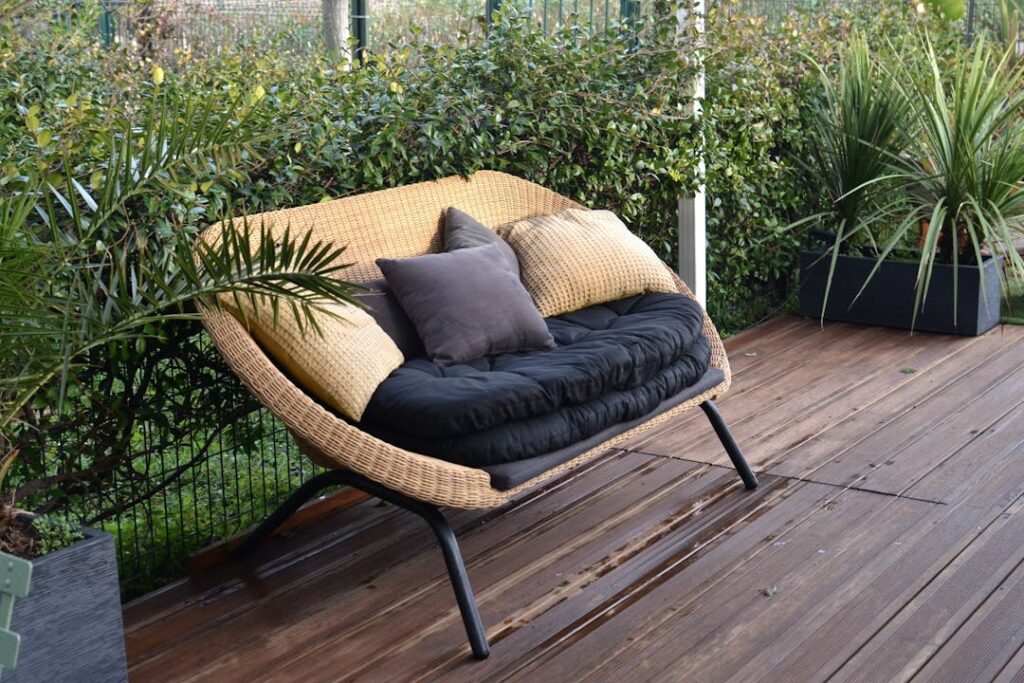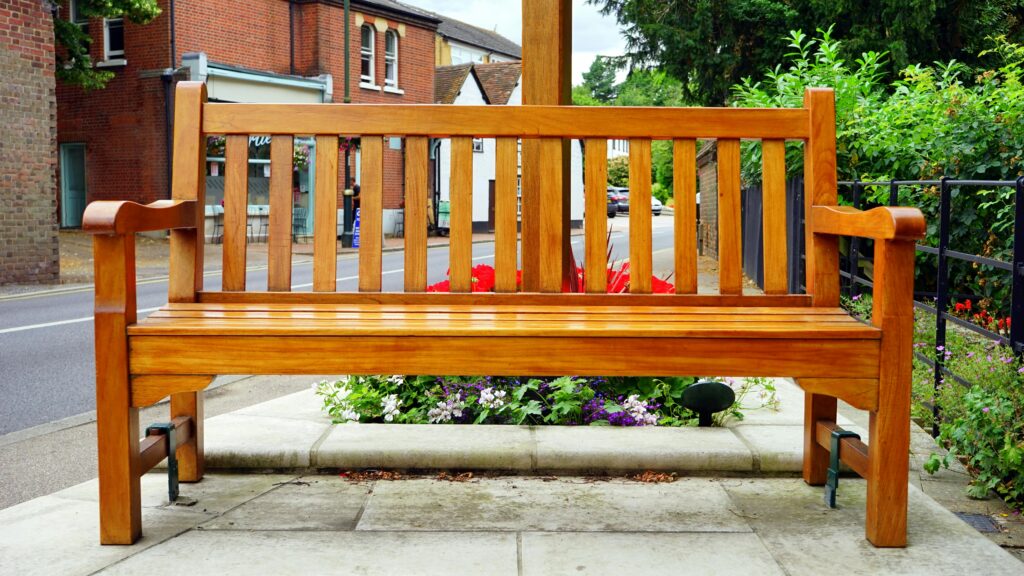Getting to know how to clean outdoor furniture gives your place a fresh breath of life. It’s like giving your outdoor space a new lease of life.
If you are tired of dull and dirty outdoor furniture that is an eyesore to your visitors, stay with us for 5 simple techniques to get sparkling clean outdoor furniture that will make your neighbors envious.
Whether it’s that wooden patio set, an outdoor garden dining set, or a metal garden bench, these simple yet effective methods will restore your furniture’s beauty and longevity.
So, let’s roll on and get started on transforming your furniture into a shining masterpiece.

Importance of Keeping Outdoor Furniture Clean
It is important to keep your outdoor furniture free of grime, which can accumulate over time, especially if you rarely use the furniture.
Firstly, we will delve into the power of pressure washing to rid your furniture of stubborn dirt and grime, revealing its true beauty.
Next, we will explore the wonders of natural cleaners—environmentally friendly and safe for your furniture and family.
But there’s more!
We will also guide you through the process of deep cleaning, sharing secrets on how to get rid of deep-seated stains and mold.
And if you’re looking to give your furniture a fresh coat of paint, fear not. Our tips and tricks will help you achieve a professional finish.
Technique 1: Regular Dusting and Sweeping
Most people neglect the care of outdoor furniture. Perhaps this is because we don’t use it as much as we do indoor furniture.
However, it really does not require as much effort. For starters, a damp cloth is all you need regularly.
Then again, sweeping and dusting the area around the furniture is a good practice too. And when not in use, cover the furniture with tarps or any other adequate covering material to protect it from dust and other debris.
To ensure mold does not form on the furniture, make it a habit to vacuum especially after the cold weather season.
Technique 2: Gentle Soap and Water Cleaning
Note: We recommend you do not use abrasive cleaners as they may destroy the longevity of your furniture.
To begin, use water and a gentle washing soap or a mild detergent. This is ideal to loosen and remove dust and dirt that accumulates on outdoor furniture over time. Use a soft bristle brush to do the spreading.
For best results, we recommend you use a garden hose with a spray nozzle after spreading the soap. This goes deep and effectively removes all stubborn particles.
Allow the furniture to dry before covering it for protection and preservation.
Technique 3: Vinegar and Water Solution for Tough Stains
Do your outdoor furniture have tough stains that cause you headaches when cleaning them?
Bird poop, grime, leaves, pollen etc. could be some problems you encounter when cleaning your furniture. Some of them, particularly grime, may prove too tough to remove with a sponge or fiber cloth.
So, what is the solution?
A water and vinegar mixture will do the job. Mix it in the ratio of 3:1 respectively then scrub the stain and give it a few minutes to work the magic.
For tougher stains, incorporate baking soda on the stain and the splash the vinegar solution.
Technique 4: Power Washing for Deep Cleaning
Now, this differs from technique no. 2 where we referred to the use of a hosepipe.
Power washing refers to the act of using pressurized machines and specialized cleaners.
The machine is powered (mostly by electric power) and is efficient in penetrating manually inaccessible places.
You can use this deep cleaning method once or twice a year.
The best items to clean using this method are:
- Garden umbrellas and canopies
- Metallic furniture
- Garden benches
- Gazebos
For plastic and wicker items, washing with water, soap or mild detergents is sufficient.

Technique 5: Protecting and Maintaining Outdoor Furniture
Regularly and where applicable, give your outdoor furniture some love by applying afresh coat of glossy paint, clear stains, etc.
But in addition, you can also sand some of the wooden furniture before applying the paint for a smoother finish.
In case you have some items that need slight repairs, you can do it yourself. Apply sealant or protective coatings as the occasion demands to retain their original beauty.
It will preserve it while also giving it a new sheen.
Again, to further protect the furniture as stated above, use covers when not in use and in harsh weather. The best covering materials are weather-resistant covers e.g.:
- Tarpaulins
- Polyester
- PVC
Important to remember, launder all the garden accessories e.g., cushions regularly and preferably by hand to prevent shrinkage. (When the laundry instructions are provided in a manual, follow them strictly).
Recommended Cleaning Products and Tools
Here is a quick check-list of the most common products and tools you will require for your outdoor furniture cleaning:
- Water, of course. We recommend the use of a hosepipe
- Mild detergent or baby soap, baking soda, and vinegar
- A brush
- Sanding paper, sealants, and painting equipment
- A power-machine, where possible
Above all, include your protective gear as we don’t want to mend one thing while we expose you to danger. Do we?
DIY vs Professional Outdoor Furniture Cleaning
Before cleaning, gather the supplies and tools you’ll need. Inspect the furniture for any damage or signs of wear and tear, addressing repairs before cleaning to avoid further damage.
While you can mange most of the cleaning and repairs, certain aspects may require the services of professional cleaners.
In case you don’t have the right equipment e.g. for vacuuming and deep cleaning, it is necessary to call in a professional.
It’s also likely that you may require eco-friendly products and protective gear for the cleaning process which you lack but which a professional will readily avail.
So, don’t shy away from seeking help for your outdoor furniture cleaning.
Common Mistakes to Avoid and Your Safety Considerations
In cleaning furniture, most of us are not keen and we simply use a sponge and water. But there are those who go a step further and use detergents and any cleaner we lay our hands on.
However, you must avoid common pitfalls such as using abrasive cleaners that can damage surfaces.
After cleaning, don’t neglect to dry furniture thoroughly. Following manufacturer’s recommendations and proper cleaning techniques is key to preserving your outdoor furniture.
Caution…
During the cleaning process, prioritize your safety by wearing gloves and protective eyewear, especially when handling chemicals.
Again, be cautious with pressure washers to avoid injury or damage to furniture surfaces.
Final Thoughts on How to Clean Outdoor Furniture
In conclusion, with the right techniques and regular maintenance, you can keep your outdoor furniture looking as good as new for years to come.
By following these foolproof tips, you’ll enjoy sparkling clean outdoor furniture that enhances your outdoor living experience.
How do you clean your outdoor furniture? If you need maintenance and cleaning support, contact us.
FAQs
How often should I clean outdoor furniture?
We recommend regular cleaning every few weeks with deeper cleaning and maintenance performed seasonally (once ot twice a year).
Can I use bleach to clean outdoor furniture?
While bleach can be effective for certain materials, it’s essential to dilute it properly and test it on a small, inconspicuous area first to avoid damage.
How do I remove rust from metal outdoor furniture?
Use a wire brush or sandpaper to remove surface rust, then apply a rust converter or primer before repainting.
What is the best way to clean mold and mildew from outdoor furniture?
A solution of bleach and water or a commercial mold and mildew cleaner can effectively remove mold and mildew stains. Scrub the affected areas gently and rinse thoroughly.
Should I cover my outdoor furniture during winter months?
Certainly! covering outdoor furniture with weather-resistant covers during winter months will protect them from harsh weather and prolong their lifespan.
Leave a Reply